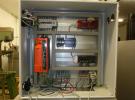Hi Guys,
I am using PS12DC as a relay to power solenoid valves on and off and it is working perfectly,
I need to use two terminals, for example, S10 and S11 to divert voltage signals between two instruments, the voltage signal is between 0 and 5v so the voltage on VS6 might be as low as 0.001V. the voltage signal source is U6 DAC1. if I switch relay S10 ON/ S11 OFF it should connect the DAC1 to device 1, S10 OFF/ S11 ON DAC1 is connected to device 2, Will that work? and will the voltage signal be affected by anything inside the relay that might lead to less acurracy



.png%3Fitok=PHGBxf6M)


.jpg%3Fitok=B1YcuDFK)
.png%3Fitok=Ybt-OlgU)
We would not recommend the PS12DC, it is specified to handle voltages between 5-28V. I don't think we have any accessories that would be a good fit for your needs, your best bet would probably be to use two separate DAC channels or use an external multiplexer controlled by a DIO.
We have an accessory called the LJTick-DAC that can provide additional analog output channels with -10V to 10V range. Note that the max current from the Tick-DAC is around 10mA:
https://labjack.com/accessories/ljtick-dac
Hi
Thank you for your reply, I think the LJTick-DAC is a perfect solution, The Voltage generated is used as a signal so no load on it at all.
Now I know how to set the DACs using the following commands :
DAQ is the U6
LJUD.AddRequest(DAQ.ljhandle, LJUD.IO.PUT_DAC, 1, 0, 0, 0);
LJUD.AddRequest(DAQ.ljhandle, LJUD.IO.PUT_DAC, 0, 0, 0, 0);
LJUD.GoOne(DAQ.ljhandle);
Considering the LJTick-DAC is connected to FI0 and FI1 as pictured
1-How do I set the voltage output?.
2-Do I need to use the screw terminals on the LJTick-DAC itself to access the signal?, I am using DB37 cable to access all the AIN and DAC channels and PS12DC is connected to the DB15
Your help is much appreciated and thank you very much in advance.
The Tick-DAC datasheet has a section titled "UD Communication" that outlines the necessary configuration and write commands to set the voltage outputs:
https://labjack.com/support/datasheets/accessories/ljtick-dac
The Tick-DAC is meant to be connected directly to screw terminal blocks on the U6 or one of our breakout boards like the CB37. The Tick-DAC can be connected to any of the DIO:
https://labjack.com/support/datasheets/accessories/cb37-v21
HI
Thank you for your reply, I am a big fan of the LabJack, I made it as part of my project and I have just ordered 20 xU6 Pro, 20x PS12DC and 10x Tick-DAC from my local LabJac distributor (www.audon.co.uk). I will be ordering lot more in the near future.
I understand I am asking a lot but I have a deadline to meet and many things to do so your help will be very much appreciated. the documentation give example in python and I am not good in python, I use c# .net
and I control the DACs using the following commands
LJUD.AddRequest(DAQ.ljhandle, LJUD.IO.PUT_DAC, 1, 0, 0, 0);
LJUD.AddRequest(DAQ.ljhandle, LJUD.IO.PUT_DAC, 0, 0, 0, 0);
LJUD.GoOne(DAQ.ljhandle);
This will set zero on both DACs, now I have the Tick-DAC connected to FI0 and FI1 how do I control the voltage on A and B using the same principle above your help will be much much appreciated.
Regards
Andrea
The example in the Tick-DAC datasheet is pseudocode and not specific to any language. Any of ePut, AddRequest (and subsequent GoOne), or eAddGoGet could be used to process the commands:
https://labjack.com/support/software/api/ud/function-reference
We have a C# Tick-DAC example in our C# example archive:
https://labjack.com/support/software/examples/ud/dotnet
Our example uses ePut. Equivalent AddRequest commands are as follows:
LJUD.AddRequest(device.ljhandle, LJUD.IO.PUT_CONFIG, LJUD.CHANNEL.TDAC_SCL_PIN_NUM, pinNum, 0, 0);
LJUD.AddRequest(device.ljhandle, LJUD.IO.TDAC_COMMUNICATION, LJUD.CHANNEL.TDAC_UPDATE_DACA, valA, 0, 0);
LJUD.AddRequest(device.ljhandle, LJUD.IO.TDAC_COMMUNICATION, LJUD.CHANNEL.TDAC_UPDATE_DACB, valB, 0, 0);
Hi
Thank you very much again for your amazing awesome products and support.
//set DAC0 to 1.1
LJUD.AddRequest(DAQ.ljhandle, LJUD.IO.PUT_DAC, 0, 1.1, 0, 0);
//set DAC1 to 1.2
LJUD.AddRequest(DAQ.ljhandle, LJUD.IO.PUT_DAC, 1, 0, 1.2, 0);
//set DACA to 1.2, Tick-DAC is connected to FI0 and FI1
LJUD.AddRequest(DAQ.ljhandle, LJUD.IO.PUT_CONFIG, LJUD.CHANNEL.TDAC_SCL_PIN_NUM, 0, 0, 0);
LJUD.AddRequest(DAQ.ljhandle, LJUD.IO.TDAC_COMMUNICATION, LJUD.CHANNEL.TDAC_UPDATE_DACA, 1.2, 0, 0);
LJUD.GoOne(DAQ.ljhandle);
1: Can I send all the above requests in one GoOne
2: Do I have to repeat this line every time I try to change the DAC A and B Values? or I can just do it in the beginning once.
LJUD.AddRequest(DAQ.ljhandle, LJUD.IO.PUT_CONFIG, LJUD.CHANNEL.TDAC_SCL_PIN_NUM, 0, 0, 0);
Thank you very much in advance.
https://labjack.com/about/compliance#eol